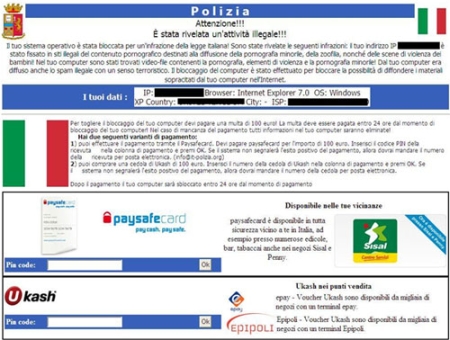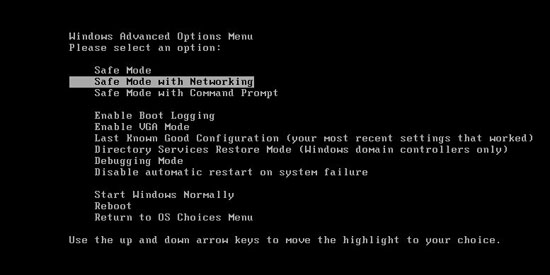When you were enjoying a video or playing a web game, a full-screen page occupied your computer telling your that for some reason, your computer had been locked and you have to pay money to unlock it? Do you even think a lawsuit will be involved with you? If the message is totally a fake thing just playing a trick to cheat you for money, what will you do? When you finish reading this article, you will know what you have to do!
Is Polizia di Stato unità di analisi sul crimine informatico virus real or fake?
Polizia di Stato unità di analisi sul crimine informatico virus hijacks users’ computers to ask for a ransom or forfeit. In order to unlock their computers, the users have to do as the ransomware says. However, it does not only invade personal computers in Italy. It has different interface and language depending on the countries. Mostly, the scam malware pretends to be the national government offices. Polizia di Stato unità di analisi is the name of the police office in Italy. There are various names of it in other country like Police Central e-crime Unit and FBI Moneypak Ransomware. Until recently, the infamous Ukash virus had only attacked computer systems located in Italy, but it spread fast. Not for a long time, it will be a huge threat for people all over the world. It brings lots of PC owners trouble and pains as well as money loss.
Like other versions of the Ukash virus or ransomware, the Polizia di Stato unità di analisi sul crimine informatico virus hijacks users’ computer and blocks all access to the Task Manager and to the infected computer’s desktop by pop-up alert claiming to be authorized by the police office, one department of the local government in Italy. The worst thing is that Polizia di Stato unità di analisi sul crimine informatico scam can escape from your anti-virus such as famous Norton, McAfee. When you start your computer in safe mode and run your security program to have a full scan, nothing will be detected from your computer. But this scam malware only can take effect via the internet. That is why when some users unplug their internet cable, they can start their computer normally. However, the files related the virus are still in your computer, so removal work is urgent and necessary. You must be very curious about how this fake thing works. Let’s learn something on it’s working principle. Firstly, the virus was made by cyber criminals who have been very well trained in computer and network field. No wonder a lot of people were taken in the first time they saw this ransomware. It looks like very legitimate with an emblem of Italian Police Association. However, in fact, as long as you are good at Photoshop program, it’s very easy to forge one. It even can mix the false with the genuine. So never think it’s really from the government. The thing really can make you be struck dumb is that it can really locked your computer system and you can’t do anything if you don’t pay them the “Fine”. If anti-virus can’t pick this virus up, there must be one solution to kill it from users computer. Yes, and the only way is to remove the virus manually.
Tips: A manual removal guide will be list below. However, the instructions are for those who are very familiar with the virus and good at computer. If you are not confident to get rid of it, you can contact YooCare/YooSecurity for help:
Appearance of Polizia di Stato unità di analisi sul crimine informatico Ransomware

Manually Get Rid of Polizia di Stato unità di analisi sul crimine informatico Scam with Substeps
Step 1: Try to plug out the internet cable then restart your computer normally. After you can see the desktop, plug in the cable again. If the virus doesn’t pop up, you can continue from step 3. (If it’s wireless connection, turn off/on instead of plugging in/out cable)
Step 2: Restart your computer in safe mode with networking. To do this, please keep pressing F8 key before windows launches until you get there shown as below:

Step 3: Press Ctrl+Alt+Del keys to open the Task manager to stop the progress of Fake Canadian Police Association Scam. Because the name will be changed fast, it will be displayed with different names with random letters.

Step 4: Delete all the files related to Polizia di Stato unità di analisi sul crimine informatico virus
Login to profile in which you are getting Polizia di Stato unità di analisi sul crimine informatico Ransomware…
Go to my computer
Then press ALT button once
Go to tools on menu bar
Goth select Folder options…
Click on view tab
Select Show hidden files, folders, and drives
Click OK button
Go to C:\Users\profile name here\AppData\Local\
HKCU\Software\Microsoft\Windows\CurrentVersion\Run\Random.exe
HKLM\Software\Microsoft\Windows\CurrentVersion\Run\Random.exe
HKLM\SOFTWARE\Microsoft\Windows NT\CurrentVersion\Image File Execution Options\FHGGn.exe\
Video Guide to Remove Cuerpo Nacional de Policía or Ukash Spanish Police Scam From Registry Editor
Please bear in mind: This virus should be removed as soon as possible. If you leave it alone, it will not only stay in your computer, but also can put your IP in very dangerous condition. However, if you can remove it in time, it can’t do any harm to your computer and won’t ask for money any more. Also please don’t pay money to this scam, even if you pay to the hackers, they won’t unlock your computer. Never believe those so called free software! Don’t download to install those stuffs in your computer. They can not only remove the Polizia di Stato unità di analisi sul crimine informatico virus for you, but also bring you much more other virus such as ransomware, scam virus even fake things. You may not be aware that those so called free software can be another cheater, which will make you gain just more loss. Please don’t take a chance to have a try. It’s nonsense. There is no free lunch! If you really can’t remove it yourself, please find an expert for assistance. This is the best choice.
All for your sake: to contact an expert such as YooCare/YooSecurity for professional service is well recommended if you really don’t know how to remove this virus:
Published by Tony Shepherd & last updated on May 31, 2013 2:26 am














Leave a Reply
You must be logged in to post a comment.